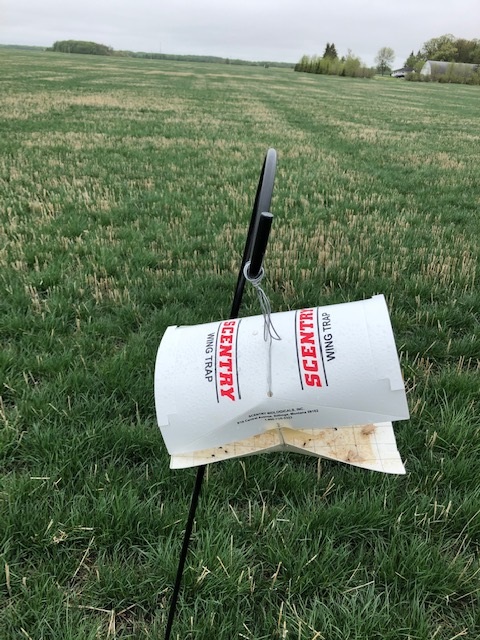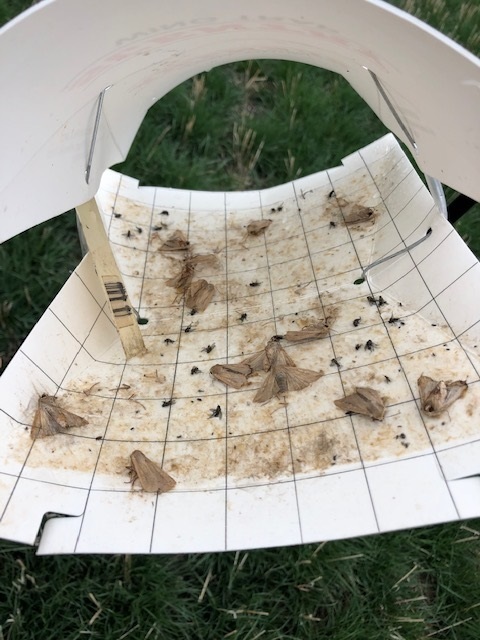By Dave Grafstrom
In 2020, a widespread outbreak of true armyworm (Mythimna unipuncta), and the subsequent feeding, caused significant damage to perennial ryegrass seed fields in northwest Minnesota. Reported ryegrass seed yield losses ranged from 0 to over 80%. The most severe damage occurred over the July 4th weekend. The majority of the perennial ryegrass fields were sprayed once or twice for armyworms.
In 2021, an armyworm moth trapping project was conducted in Roseau County with the objectives to determine: 1) the onset of armyworm moth migration and, 2) the scope and severity of armyworm moths in perennial ryegrass seed fields. Armyworm moths (males only) were trapped with a pheromone type trap (Scentry wing trap; Figure 1) which were installed on field edges, or in the middle of grass seed fields. Traps were affixed to a tree branch, post, or hanging basket rod approximately 4 feet off the ground at four locations.
Cool fronts with wind directions from the north and northwest dominated the weather patterns in April and the first 10 days of May in 2021 (North Dakota Agricultural Weather Network). Armyworm moth traps were placed in fields the week of May 10th. Traps were inspected weekly, until moth capture, and every two to three days after moth capture and again, weekly, if no moths were captured in the trap. Armyworm moths were trapped on a sticky board and these trapped moths were removed from the sticky trap (Figure 2). In heavy moth flights, a new sticky base replaced the one covered with moths. A new pheromone lure replaced the old lure approximately every three weeks.
The four armyworm moth trapping locations in 2021:
- Location 1: Jadis Township, Section 5, SW quarter. Trap placed in the middle of perennial ryegrass field.
- Location 2: Jadis Township, Section 9, NE quarter. Trap in a field border between a Kentucky bluegrass and perennial ryegrass seed field.
- Location 3: Laona Township, Section 10, NE quarter. Trap was in field a boundary of spring wheat and a perennial ryegrass seed field.
- Location 4: Jadis Addition, Section 32, SE quarter. Trap was in middle of a Kentucky bluegrass seed field.
April of 2021 was approximately 10 degrees cooler than average (North Dakota Agricultural Weather Network). Average daily high temperatures in May and June were approximately 15 degrees warmer than average. Perennial ryegrass began to shed pollen on June 17 and swathing began the week of July 19th. Traps were removed from the perennial ryegrass and Kentucky bluegrass fields before fields were swathed. One trap was moved to a grassy area at the U of MN-Magnusson Research Farm on July 19th.
This was the first year of this armyworm moth trapping project, so we don’t have historical data to document the onset of armyworm moth migration and the numbers of moths collected in pheromone traps. However, the data in 2021 (Table 1) indicates the possibility of three moth flights into the perennial ryegrass growing region of MN with one after ryegrass harvest.
The weeks with the most total armyworm moth captured are:
- May 18-25 = 77
- May 30-June 4 = 20
- June 23-19 = 42
- July 22-29 = 38 moths captured (after ryegrass harvest)
The data in Table 1 would suggest that traps placed in the middle of perennial ryegrass fields (Location 1) were more effective in the capture of armyworm moths (61) than if placed on field edges of ryegrass (33), boundary of wheat and ryegrass (24), or Kentucky bluegrass fields (22). However, caution must be used when making any conclusions as 2020 was the first year of this armyworm moth trapping project.
| Date | Location 1 | Location 2 | Location 3 | Location 4 | Total |
|---|---|---|---|---|---|
| 5/18 | 4 | 0 | 0 | 0 | 4 |
| 5/21 | 14 | 10 | 0 | 2 | 26 |
| 5/23 | 15 | 11 | 9 | 1 | 36 |
| 5/25 | 7 | 0 | 0 | 4 | 11 |
| 5/29 | 8 | 2 | 0 | 3 | 13 |
| 5/31 | 1 | 0 | 3 | 0 | 4 |
| 6/3 | 2 | 0 | 0 | 1 | 3 |
| 6/11 | 0 | 0 | 1 | 1 | 2 |
| 6/13 | 4 | 4 | 0 | 2 | 10 |
| 6/15 | 4+2* | 3+2* | 7 | 5 | 19 |
| 6/17 | 2 | 2+1* | 0 | 3 | 7 |
| 6/20 | 0 | 1 | 4 | 0 | 5 |
| 6/24 | 0 | 0 | 0 | 0 | 0 |
| Total | 61 | 33 | 24 | 22 | 140 |
*Spotted cutworm moth
In 2021, grasshoppers were a severe insect problem in perennial ryegrass fields. The majority of the perennial ryegrass fields were sprayed once, or twice for grasshoppers. As a result, armyworms didn’t cause production problems as the majority of perennial ryegrass seed fields were sprayed with an insecticide for grasshoppers in 2021.
This armyworm moth trapping project will continue in 2022. Additional locations will be added in 2022 to increase the scope of this armyworm moth trapping project in the perennial ryegrass seed production geography of northwest Minnesota.
For more on UMN perennial ryegrass seed production research, please see our Seed Production section.

